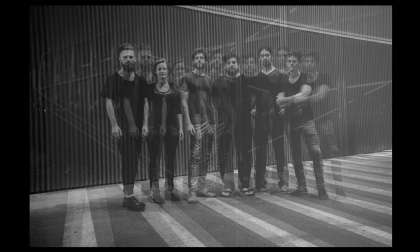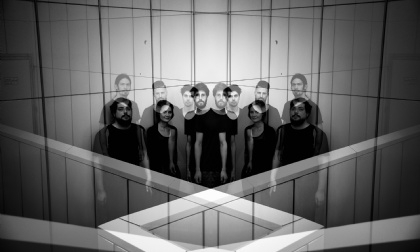|
|
 |
Gnigler
Straight On, Downstairs, 2nd Door Left |
| 01 |
|
eins |
04:20 |
 |
|
|
 |
|
|
|
| 02 |
|
sechs |
05:30 |
 |
|
|
 |
|
|
|
| 03 |
|
eing |
04:13 |
 |
|
|
 |
|
|
|
| 04 |
|
Kunstgriff |
09:16 |
 |
|
|
 |
|
|
|
| 05 |
|
drei |
03:03 |
 |
|
|
 |
|
|
|
| 06 |
|
sieben |
04:22 |
 |
|
|
 |
|
|
|
| 07 |
|
igen |
03:21 |
 |
|
|
 |
|
|
|
| 08 |
|
fünf |
07:08 |
 |
|
|
 |
|
|
|
| 09 |
|
vier |
03:03 |
 |
|
|
 |
|
|
|
| 10 |
|
Zufznac |
09:37 |
 |
|
|
 |
|
|
|
| 11 |
|
zwei |
04:15 |
 |
|
|
 |
|
|
|
 |
|
|
|
|
|
|
|
 mp3 320 kB/s mp3 320 kB/s |
|
 |
|
|
Gnigler - Straight On, Downstairs, 2nd Door Left |
|
9,99 € | download |
|
 |
|
 |
| Editorial |
|
 |
|
| © Sabine Pichler |
|
Founded in 2013 by the young Austrian saxophonist Jakob Gnigler, the sextet has created its own musical world, full of the unexpected and the unpredictable. The individual versus the collective, composition versus improvisation, listening habits versus artistic intention – everywhere contrasts are celebrated, established thought patterns questioned, hierarchies upended.
The result of these musical ground erosions, fault lines, shifting of tectonic plates, is not experimental chamber music, not (free) jazz, not new music. It is all of these together. The Gnigler musicians say: “We play without being ruled by the question of may, might and should”. Or, to put it more exactly, “The balance is held between both positions – ‘nothing’s happening’ and ‘everything’s happening’.” In the end, then, no one knows what is coming next.
And a good thing, too.
|
 |
| Lineup |
|
Jakob Gnigler, compositions, tenor saxophone
Philipp Harnisch, alto saxophone
Alexander Kranabetter, trumpet
Simon Frick, e-violin
Judith Ferstl, double bass
Niki Dolp, drums
All tracks written and composed by Jakob Gnigler
Recorded, mixed & mastered by Werner Angerer
|
 |
| Artist’s Notes |
|
Thoughts on the music
By Jakob Gnigler
Underlying the latest compositions for the ensemble is both a re ection on form and structure in improvisation, and an examination of the individual in the ensemble – a tug of war between the solo and the collective.
This exchange proves full of contrasts: in standalone solos, the musicians are sometimes truly totally alone and solely responsible. Alternatively, each individual plays alone at the same time; or everyone plays together at the same time.
Form
The re ections on form should be brie y expounded here: forms are influenced by repetitions. Certain passages are repeated, creating a structure or a system, a mesh of chords that is in any case predictable. And it is exactly this predictability which is broken up in some way in the Gnigler compositions. This might come about through changes in temporal components, in other words no xed timing pa ern or even no metre at all; or through the overlapping of multiple levels which take place independently from one another, not necessarily at the same time.
The improvisations in the compositions do not work to ll out the form (as is usual in traditional jazz), but become instead a formative, important part of the whole.
The form fixed at the outset is countered then by the solo sections, where the musicians are able to drastically intervene in the whole piece, gaining great freedom to shape how it develops with lasting e ect. The appeal here is the unpredictability for the other musicians: they don’t know what is coming.
The solo improvisation is at the same time a demanding undertaking, where individual freedoms are quickly pitted one against the other.
Through the individual solo sections, solo improvisations without any kind of template become extremely important to the individual musicians, and their decisions or musical inspirations are decisive in shaping the nal outcome. Although these solo sections are conceived of as part of the compositions, they can also be seen as individual pieces. A piece within a piece then, which can exist independently of its frame and open up its own little world.
In the transitions between improvisations, the overlap gives rise to short improvised duets. The end of the first improvisation and the beginning of the second. The solo thought is broken off here at the latest and extended in the improvised duet. Whether these two voices now play together with one another or next to one another remains open. The decision lies in principle with the musician who comes in as the second.
The music is thus shaped by a “tussle” between musical individuality and the stipulations of the composer. [...]
|
 |
| About |
|
 |
|
| © Sabine Pichler |
|
Formed in Vienna in 2013, the sextet has created its own musical world. The music in this world cannot be de nitively classi ed as jazz, touching instead on experimental music and slipping sometimes into new music.
Back then, saxophonist and band leader Jakob Gnigler gathered around him a ock of young musicians with the intention of wiring together their idiosyncratic musical worlds into one bigger one.
The result is impossible to categorise as a single style. It is not the mixture of (free) jazz and new music. Gnigler is both. Gnigler is not trying to do justice to any particular style, requirement or custom. Gnigler just plays, without being permanently in sway to the question of could, must and should. And the very fact that it is not trying to be something means it is everything.
|
 |
| Press Commentaries |
|
"Das Sextett mischt Bop-Phrasierungen mit Neue-Musik-Clustern, growlendes Saxofon mit Kammermusik-Erkundungen, spannende Bläsersätze mit Geräuschcollagen. Ständig wechseln Stile und Rhythmen, die Ideen jagen einander, und zuweilen teilt sich die Band sogar in eine tonale und eine atonale Fraktion. Das alles ist mit viel Temperament gespielt - offensiv, frei, löwenmutig." Hans-Jürgen Schaal in Jazzthetik, Mai 2018
|
 |
| For further information visit: |
|
|
| Instrumental | Ensemble | BRIGHT colors Edition |
|
 |
 |
| Recommendation |
|
|
|
|
The fascinating debut album by the Austrian clarinetist and composer Christoph Zimper: emergent, profound and exciting!  |
 |
|
|
|
|
[...] contains pop music of stunning grandeur, and of moving simplicity. Sincerely recommended!  |
 |
|
|
|
|
A musical look from the future to the present.  |
 |
|
|


